Nationality Argentine Role Race car driver Entries 52 (51 starts) Children Oscar Cacho Espinosa | Wins 24 Siblings Ruben Renato Fangio Name Juan Fangio | |
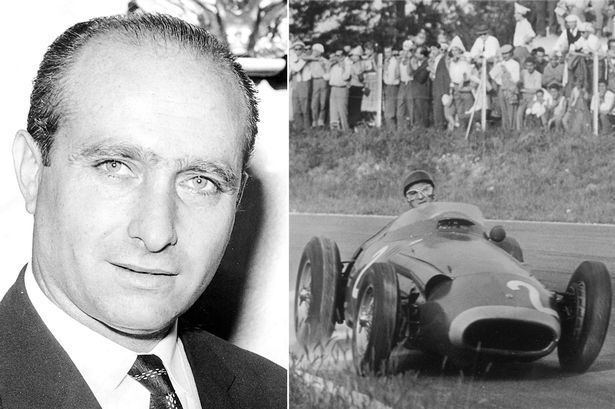 | ||
Active years 1950 – 1951, 1953 – 1958 Championships 5 (1951, 1954, 1955, 1956, 1957) Parents Loreto Fangio, Herminia Derano Similar People Giuseppe Farina, Alain Prost, Niki Lauda, Jim Clark, Phil Hill | ||
Cuban race car driver juan manuel fangio kidnapped and crash kills 6 people publicdomainfootage com
Juan Manuel Fangio Déramo ([ˈfanχjo], [ˈfandʒo]; 24 June 1911 – 17 July 1995), nicknamed El Chueco ("the bowlegged one", also commonly translated as "bandy legged") or El Maestro ("The Master"), was an Argentine racing car driver. He dominated the first decade of Formula One racing, winning the World Drivers' Championship five times.
Contents
- Cuban race car driver juan manuel fangio kidnapped and crash kills 6 people publicdomainfootage com
- F1 legend juan manuel fangio
- Early life
- Early racing career
- Overview
- World championship successes
- Kidnapping
- Later life and death
- Private life
- Legacy
- World Championship results
- Formula One records
- References

From childhood, he abandoned his studies to pursue auto mechanics. In 1938, he debuted in Turismo Carretera, competing in a Ford V8. In 1940, he competed with Chevrolet, winning the Grand Prix International Championship and devoted his time to the Argentine Turismo Carretera becoming its champion, a title he successfully defended a year later. Fangio then competed in Europe between 1947 and 1949 where he achieved further success.
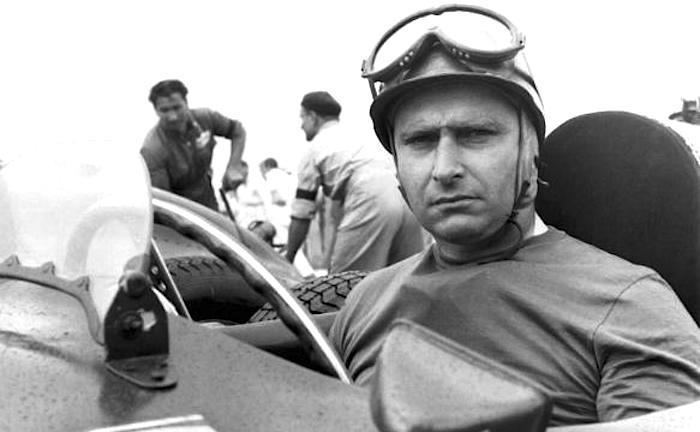
He won the World Championship of Drivers five times—a record which stood for 47 years until beaten by Michael Schumacher—with four different teams (Alfa Romeo, Ferrari, Mercedes-Benz and Maserati), a feat that has not been repeated. A member of the Formula 1 Hall of Fame, he is regarded by many as one of the greatest F1 drivers of all time and holds the highest winning percentage in Formula One – 46.15% – winning 24 of 53 Formula One races he entered. Fangio is the only Argentine driver to have won the Argentine Grand Prix, having won it four times in his career—the most of any driver.
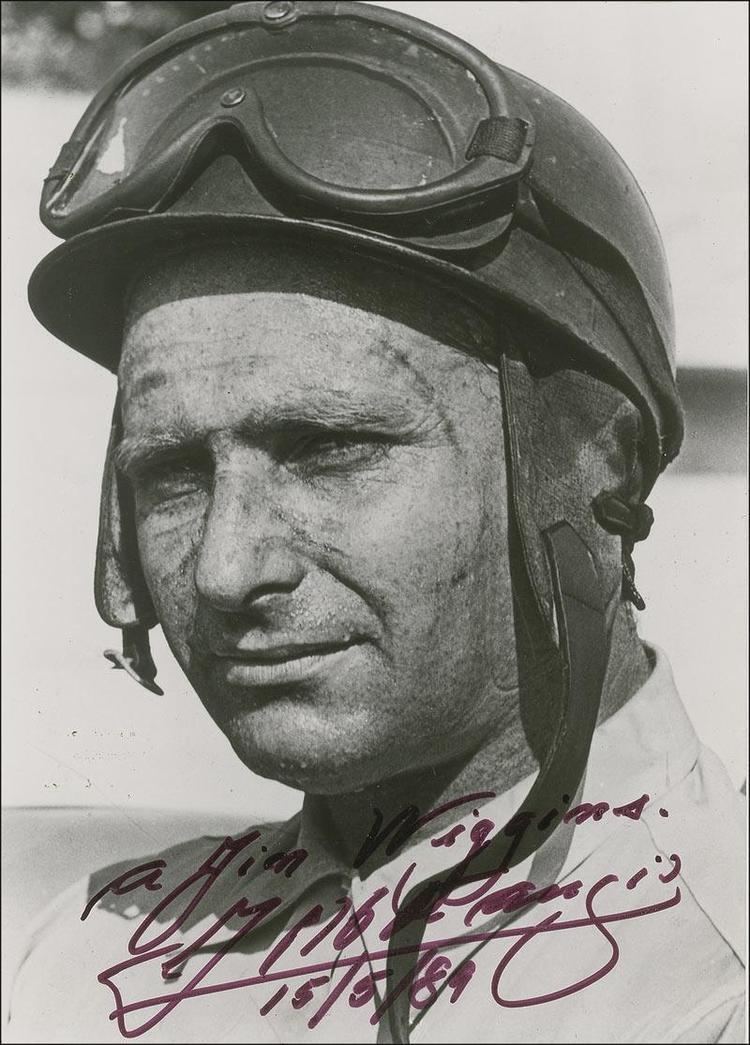
After retirement, Fangio presided as the honorary president of Mercedes-Benz Argentina from 1987, a year after the inauguration of his museum, until his death in 1995. In 2011, on the centenary of his birth, Fangio was remembered around the world and various activities were held in his honor.
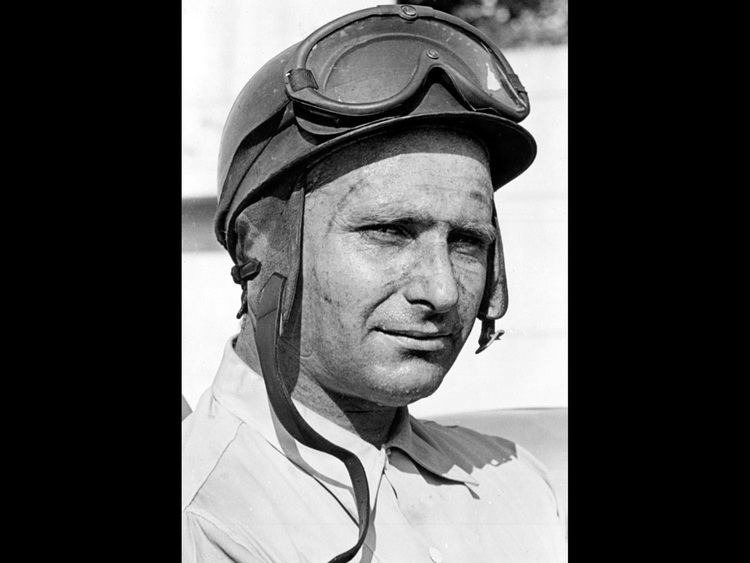
F1 legend juan manuel fangio
Early life
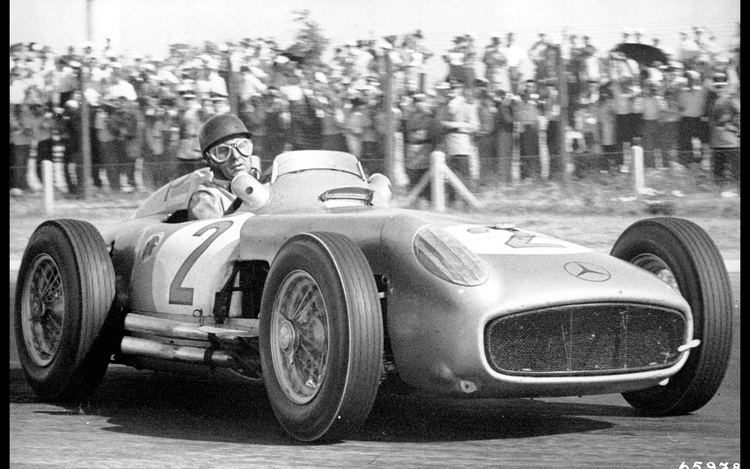
Fangio's grandfather, Giuseppe Fangio, emigrated to Buenos Aires from Italy in 1887. Giuseppe managed to buy his own farm near Balcarce within three years by making charcoal from tree branches. His father, Loreto, emigrated to Argentina from the small central Italian town of Castiglione Messer Marino in the Chieti province of the Abruzzo region. His mother, Herminia Déramo, was from Tornareccio, slightly to the north. They married on 24 October 1903, and lived on farms where Herminia was a housekeeper and Loreto worked in the building trade, becoming an apprentice stonemason.
Fangio was born on San Juan's Day 1911 at 12:10 a.m. in Balcarce, a small city in southern Buenos Aires Province, Argentina. His birth certificate was mistakenly dated 23 June by the Register of Balcarce. He was the fourth of six children. In his childhood he became known as El Chueco, the bandy legged one, for his skill in bending his left leg around the ball to shoot on goal during football games.
Fangio started his education at the School No. 4 of Balcarce, Calle 13 before transferring to School No. 1 and 18 Uriburu Av. When Fangio was 13, he dropped out of school and worked as an assistant mechanic. When he was 16, he started riding as a mechanic for his employer's customers. He developed pneumonia, which almost proved fatal, after a football game where hard running had caused a sharp pain in his chest. He was bed-ridden for two months, cared for by his mother.
After recovering, Fangio served compulsory military service at the age of 21. In 1932 he was enlisted at the Campo de Mayo cadet school near Buenos Aires. His driving skills caught the attention of his commanding officer, who appointed Fangio as his official driver. Fangio was discharged before his 22nd birthday after taking his final physical examination. He returned to Balcarce where he aimed to further his football career. Along with his friend José Duffard he received offers to play at a club based in Mar del Plata. Their teammates at Balcarce suggested the two work on Fangio's hobby of building his own car and his parents donated space in a small section of their home where a rudimentary shed was built.
Early racing career
After finishing his military service, Fangio opened his own garage and raced in local events. He began his racing career in Argentina in 1934, driving a 1929 Ford Model A, which he had rebuilt. These local events were unlike anything in Europe or North America, they were long-distance races held on mostly dirt roads up and down South America. During his time racing in Argentina, he drove Chevrolet cars and was Argentine National Champion in 1940 and 1941. One particular race, which he won in 1940, the Gran Premio del Norte, was almost 10,000 km long. This race started in Buenos Aires and ran up through the Andes to Lima, Peru and back again, taking nearly two weeks with stages held each day. Following many successes driving mainly modified American stock cars; he was funded by the Argentine Automobile Club and the Argentine government and sent to Europe in 1948 to continue his career.
In the Tourism Highway category, Fangio participated in his first race between 18 and 30 October 1938 as the co-pilot of Luis Finocchietti. Despite not winning the Argentine Road Grand Prix, Fangio drove most of the way and qualified in seventh place. In November of that year, he entered the "400 km of Tres Arroyos ", but it was suspended due to a fatal accident.
In 1939, the circuit was in Forest, which conformed well with his last involvement with a Ford V8. With Hector Tieri as his partner, they led Turismo Carretera that year with a Chevrolet, competing for the Argentine Grand Prix. Suspended by a strong rain and resumed in Cordoba, he managed their first stage victory, winning the fourth stage from Catamarca to San Juan. In October, after 9500 km of competition in Argentina, Bolivia and Peru, he won his first race in Turismo Carretera, the Grand Prix International North. He became the first TC Argentine Champion to have driven a Chevrolet.
In 1941, he beat Oscar Gálvez in the Grand Prix Getúlio Vargas in Brazil. For the second time, Fangio was crowned champion of Argentine TC. In 1942, he ended South Grand Prix in tenth place in accordance with the general classification. In April he won the race "Mar y Sierras" and had to suspend the mechanical activity due to the start of World War II.
In 1946, after a brief period of inactivity, Fangio returned to racing with two races in Morón and Tandil driving a Ford T. In February 1947, Fangio competed at National Mechanics (MN) in the circuit Retirement, and on 1 March, he started the race for Rosario City Award. Subsequently, Fangio triumphed in the circuit 'Double Back Window' Race.
Overview
Fangio, unlike later Formula One drivers, started his racing career at a mature age and was the oldest driver in many of his races. During his career, drivers raced with almost no protective equipment on circuits with no safety features, although F1 cars back in the 1950s were a lot slower, less physically demanding to drive and less advanced than F1 cars 4 and more decades later. Fangio had no compunction about leaving a team, even after a successful year or even during a season, if he thought he would have a better chance with a better car. As was then common, several of his race results were shared with teammates after he took over their car during races when his own had technical problems. His rivals included Alberto Ascari, Giuseppe Farina and Stirling Moss. Throughout his career, Fangio was backed by funding from the Argentine government of Juan Perón.
World championship successes
Fangio's first entry into Grand Prix racing came in the Grand Prix de l'ACF at Reims, where he started his Simca Gordini from 11th on the grid but retired. Back to South America, during a long-distance race, he went off the road in Peru and tumbled down a mountainside. His co-driver, Daniel Urrutia was thrown out of the car, and when Fangio found him, he was dying. Following Urrutia's death, he considered quitting the sport. But he resolved to carry on and returned to Europe the following year, and raced in Sanremo, but having upgraded to a Maserati 4CLT/48 sponsored by the Automobile Club of Argentina he dominated the event, winning both heats to take the aggregate win by almost a minute over Prince Bira. Fangio entered a further six Grand Prix races in 1949, winning four of them against top-level opposition.
For the first World Championship of Drivers in 1950, Fangio was taken on by the Alfa Romeo team alongside Farina and Luigi Fagioli. With competitive racing machinery following the Second World War still in short supply, the pre-war Alfettas proved dominant. Fangio won each of the three races he finished, but Farina's three wins and a fourth place allowed him to take the title. In 1950s non-championship races Fangio took a further four wins and two seconds from eight starts. Fangio won three more championship races for Alfa in 1951 in the Swiss, French and Spanish Grands Prix, and with the improved Ferraris taking points off his teammates, Fangio took the title in the final race, six points ahead of Ascari.
With the 1952 World Championship being run to Formula Two specifications, Alfa Romeo were unable to use their supercharged Alfettas and withdrew. As a result, the defending champion found himself without a car for the first race of the championship and remained absent from F1 until June, when he drove the British BRM V16 in non-championship F1 races at Albi and Dundrod. Fangio had agreed to drive for Maserati in a non-championship race at Monza the day after the Dundrod race, but having missed a connecting flight he decided to drive through the night from Paris, arriving half an hour before the start. Badly fatigued, Fangio started the race from the back of the grid but lost control on the second lap, crashed into a grass bank, and was thrown out of the car as it flipped end over end. He was taken to hospital with multiple injuries, the most serious being a broken neck, and spent the rest of 1952 recovering in Argentina.
In Europe, and back to full racing fitness in 1953, Fangio rejoined Maserati for the championship season, and against the dominant Ferraris led by Ascari he took a lucky win at Monza. Fangio qualified second with Bonetto seventh, and Fangio set fastest lap on his way to a 1.4-second victory over Nino Farina while Bonetto retired out of fuel. Along with that win, Fangio secured three second places to finish second in the Championship, and also came third first time out in the Targa Florio. He ended 1953 by winning the dauntingly dangerous and difficult 2,000 mi (3,200 km) Carrera Panamericana in Mexico driving a Lancia D24; Fangio was able to win this 5-day open public road rally that started at the Mexico-Guatemala border and ended at the Mexico-United States border in record time- about 18 and a half hours total driving time.
In 1954 Fangio raced for Maserati until Mercedes-Benz entered competition in mid-season. Winning eight out of twelve races (six out of eight in the championship) in that year, he continued to race with Mercedes—driving the W196 Monoposto—in 1955 in a team that included Stirling Moss. For 1955, Fangio subjected himself to a training programme which was strenuous in an effort to keep up his fitness levels high which was comparable to his younger rivals. He won a particularly brutal race at the Gran Premio de la Republica Argentina. This race was run during a gruelling heat wave, and with track temperature of over 135 °F (57 °C), few drivers other than Fangio were able to complete the race. At the end of the second successful season (which was overshadowed by the 1955 Le Mans disaster in which more than 80 spectators were killed, an accident which happened right in front of and nearly killed him) Mercedes withdrew from racing and after four attempts, Fangio would never race at Le Mans again.
In 1956 Fangio moved to Ferrari to win his fourth title. Enzo Ferrari and Fangio did not have a very warm relationship, despite their shared success. Fangio took over his teammate's cars after he suffered mechanical problems in three races, the Argentine, Monaco and Italian Grands Prix. In each case the points were shared between the two drivers. At the season-ending Italian Grand Prix, Fangio's Ferrari teammate Peter Collins, who was in a position to win the World Championship with just 15 laps to go, handed over his car to Fangio. They shared the six points won for second place, giving Fangio the World title.
In 1957 Fangio returned to Maserati, who were still using the same iconic 250F which Fangio had driven at the start of 1954. Fangio started the season with a hat-trick of wins in Argentina, Monaco and France, before retiring with engine problems in Britain. At the next race, the German Grand Prix at the Nürburgring circuit, Fangio needed to extend his lead by six points to claim the title with two races to spare. From pole position Fangio dropped to third behind the Ferraris of Mike Hawthorn and Collins but managed to get past both by the end of the third lap. Fangio had started with half-full tanks since he expected that he would need new tyres halfway through the race. In the event Fangio pitted on lap 13 with a 30-second lead, but a disastrous stop left him back in third place and 50 seconds behind Collins and Hawthorn. Fangio came into his own, setting one fastest lap after another, culminating in a record-breaking time on lap 20 a full eleven seconds faster than the best the Ferraris could do. On the penultimate lap Fangio got back past both Collins and Hawthorn, and held on to take the win by just over three seconds. With Musso finishing down in fourth place, Fangio claimed his fifth title. This performance is often regarded as the greatest drive in Formula One history, and it was to be Fangio's last win.
After his series of consecutive championships he retired in 1958, following the Grand Prix de l'ACF. Such was the respect for Fangio, that during that final race, race leader Hawthorn had lapped Fangio and as Hawthorn was about to cross the line, he braked and allowed Fangio through so he could complete the 50-lap distance in his final race. He would cross the line over two minutes down on Hawthorn. Getting out of the Maserati after the race, he said to his mechanic simply, "It is finished." He was famous for winning a race at the slowest possible speed. He won 24 World Championship Grands Prix from 52 entries – a winning percentage of 46.15%, the best in the sport's history (Alberto Ascari, who is second best, holds a winning percentage of 40.63%).
Kidnapping
The Batista Dictatorship of Cuba established the non-Formula One Cuban Grand Prix in 1957. Fangio won the 1957 event, and had set fastest times during practice for the 1958 race. On 23 February 1958, two unmasked gunmen of Fidel Castro's 26th of July Movement entered the Hotel Lincoln in Havana and kidnapped Fangio at gunpoint. The motive was simple: By capturing the biggest name in motorsport the rebels were showing up the government and attracting worldwide publicity to their cause. But despite the shocking news spreading across the globe, President Batista would not be outdone and ordered the race to continue as usual while a crack team of police hunted down the kidnappers. They set up roadblocks at intersections, and guards were assigned to private and commercial airports and to all competing drivers.
Fangio was taken to three separate houses. His captors allowed him to listen to the race via radio, bringing a television for him to witness reports of a disastrous crash after the race concluded. In the third house, Fangio was allowed his own bedroom but became convinced that a guard was standing outside of the bedroom door at all hours. The captors talked about their revolutionary programme which Fangio had not wished to speak about as he did not have an interest in politics. Convinced that he was not in danger he went on to develop a case of Stockholm Syndrome, admitting afterwards that he sympathised with his captors' actions: "Well, this is one more adventure. If what the rebels did was in a good cause, then I, as an Argentine, accept it." Fangio was released after 29 hours and he remained a good friend of his captors afterwards.
The captors motives were to force the cancellation of the race in an attempt to embarrass the Batista regime. After Fangio was handed over to the Argentine embassy soon after the race, many Cubans were convinced that Batista was losing his power because he failed to track the captors down. The Cuban Revolution concluded in January 1959, cancelling the 1959 Cuban Grand Prix. The Fangio kidnapping was dramatized in a 1999 Argentine film directed by Alberto Lecchi, Operación Fangio.
Later life and death
When Fangio attended the 1958 Indianapolis 500, he was offered $20,000 to qualify in a Kurtis-Offenhauser by the car's owner, George Walther, Jr. (Fangio had previously attended the 500 in 1948 at which time he expressed his interest in competing the race.) However, he was unable to qualify. Walther allowed Fangio to stand aside (before a contract with British Petroleum came to light), still he did not want another driver to take over Fangio's position.
During the rest of his life after retiring from racing Fangio sold Mercedes-Benz cars, often driving his former racing cars in demonstration laps. Even before he joined the Mercedes Formula One team, in the mid-1950s, Fangio had acquired the Argentine Mercedes concession. He was appointed President of Mercedes-Benz Argentina in 1974, and its Honorary President for Life in 1987.
Fangio was also the flagman for the 1975 Winston 500 (NASCAR race).
Fangio was the special guest of the 50th anniversary 1978 Australian Grand Prix at the Sandown Raceway in Melbourne (7 years before the Australian Grand Prix became a round of the World Championship in 1985). After awarding the Lex Davison Trophy to race winner Graham McRae (who stated that meeting Fangio was a bigger thrill than actually winning the race for the 3rd time), the legendary Argentinian drove his 1954 and 1955 World Championship-winning Mercedes-Benz W196 in a spirited 3 lap exhibition against 3 other cars, including the 1966 World Championship winning Brabham BT19 driven by Australia's own triple World Champion Jack Brabham. Despite his car having been given away over 10 years previously to the Repco Brabham, Fangio pushed the Australian all the way to the flag. Before the "race", Fangio (who at 67 years of age and not having raced competitively in 20 years, still held a full FIA Super Licence) had stated his intention of racing and not just putting in a demonstration drive.
At the beginning of the 1980s Fangio underwent successful bypass surgery to correct a heart condition. He had also been suffering from kidney failure for some time before his death.
In 1980 Konex Foundation granted him the Diamond Konex Award as the best Sportsman of the decade in Argentina.
Following his retirement, Fangio was active in assembling automotive memorabilia associated with his racing career. This led to the creation of the Museo Juan Manuel Fangio, which opened in Balcarce in 1986.
Fangio was inducted into the International Motorsports Hall of Fame in 1990. He returned to the spotlight in 1994, when he publicly opposed a new Province of Buenos Aires law denying driving licences to those over 80 (which included Fangio). Denied a renewal of his card, Fangio reportedly challenged Traffic Bureau personnel to a race between Buenos Aires and seaside Mar del Plata (a 400 km (250 mi) distance) in two hours or less, following which an exception was made for the five-time champion.
In 1990, Fangio met the three-time world champion, Ayrton Senna, who had genuinely felt the encounter had reflected the mutual affection for both drivers.
Juan Manuel Fangio died in Buenos Aires in 1995, at the age of 84 from kidney failure and pneumonia; he was buried in his home town of Balcarce. His pallbearers were his younger brother Ruben Renato ("Toto"), Moss, compatriot racers José Froilán González and Carlos Reutemann, Jackie Stewart and the president of Mercedes-Benz Argentina at the time.
Private life
In the early 1950s, Fangio was involved in a road accident when he was forced to swerve to avoid an oncoming truck. The car, a Lancia Aurelia GT clipped a pole, spinning twice and threw Fangio out, which led him to sustain grazed elbows. One passenger stated the incident was the first time Fangio had been so terrified since the Korean War.
Fangio was never married, but was involved in a romantic relationship with Andrea Berruet whom he broke up with in 1960. They had a son named Oscar Cacho Espinosa who was acknowledged as the unrecognised son of Fangio in 2000. In July 2015, an Argentinian court ruling ordered exhumation of Fangio's body after Espinosa's claims to be the unacknowledged son of the former race car driver. In December 2015, the Court confirmed that Espinosa was indeed Fangio's son. In February 2016, it was confirmed that Rubén Vázquez is Fangio's son.
His nephew, Juan Manuel Fangio II, is also a successful racing driver.
Legacy
The official Formula One website states of Fangio: "Many consider him to be the greatest driver of all time." Several highly successful later drivers, such as Jim Clark, Alain Prost, Ayrton Senna and Michael Schumacher, have been compared with Fangio, however the qualities required for success, levels of competition, and racing rules have changed over time.
His record of five World Championship titles stood for 45 years before German driver Michael Schumacher surpassed it in 2003. Schumacher said, "Fangio is on a level much higher than I see myself. What he did stands alone and what we have achieved is also unique. I have such respect for what he achieved. You can't take a personality like Fangio and compare him with what has happened today. There is not even the slightest comparison."
In his home country of Argentina, Fangio is revered as one of the greatest sportsmen the nation has ever produced. Argentines often refer to him as El Maestro, el mejor, which translates into The Master, the best one.
The first Michel Vaillant story was partly based on an imaginary conflict stirred up by fictional newspaper The New Indian on Fangio winning the World Championship at the Indy 500.
Six statues of Fangio, sculpted by Catalan artist Joaquim Ros Sabaté, stand at race venues around the world: Puerto Madero, Buenos Aires; Monte Carlo, Monaco; Montmeló, Spain; Nürburgring, Germany; Stuttgart-Untertürkheim, Germany; and Monza, Italy.
The Museo Juan Manuel Fangio was established in Balcarce (Fangio's birthplace) in 1986.
Argentina's largest oil company, Repsol YPF, launched the "Fangio XXI" gas brand. The Zonda 2005 C12 F was originally intended to be named "Fangio F1," but was changed out of respect after his death. Maserati created a special website in 2007 to commemorate the 50th anniversary of his fifth and final world championship triumph. A Mercedes-Benz W196R Formula 1 race car, driven by Fangio in his World Championship-qualifying Grand Prix races in 1954 and 1955 was sold for a record $30 million at an auction in England on 12 July 2013.
Peter Peter Hughes' 2010 album "Fangio" is a concept album about a fantastical version of Fangio.
World Championship results
(key) (Races in bold indicate pole position; races in italics indicate fastest lap)
* Shared drive. † Car ran with streamlined, full-width bodywork.
Formula One records
Fangio holds the following Formula One records:
